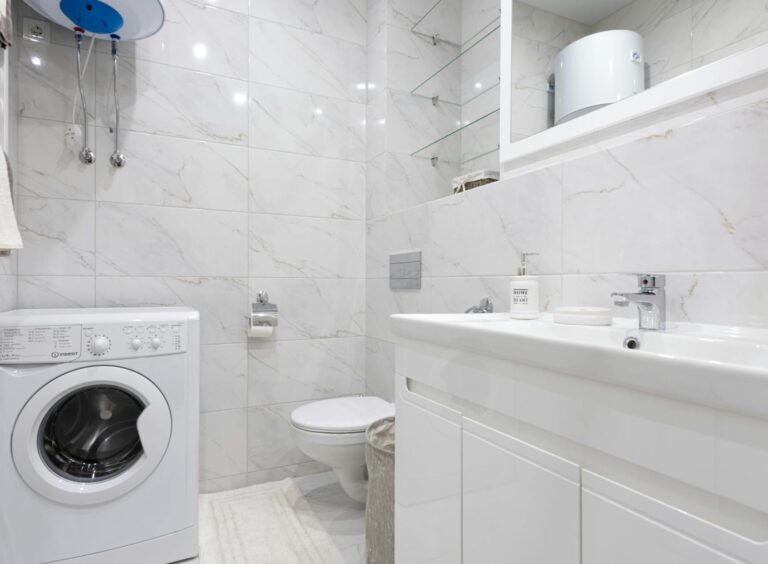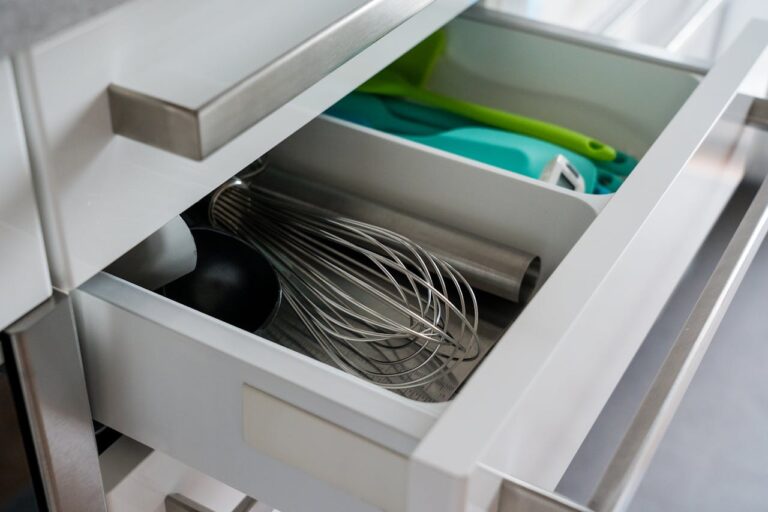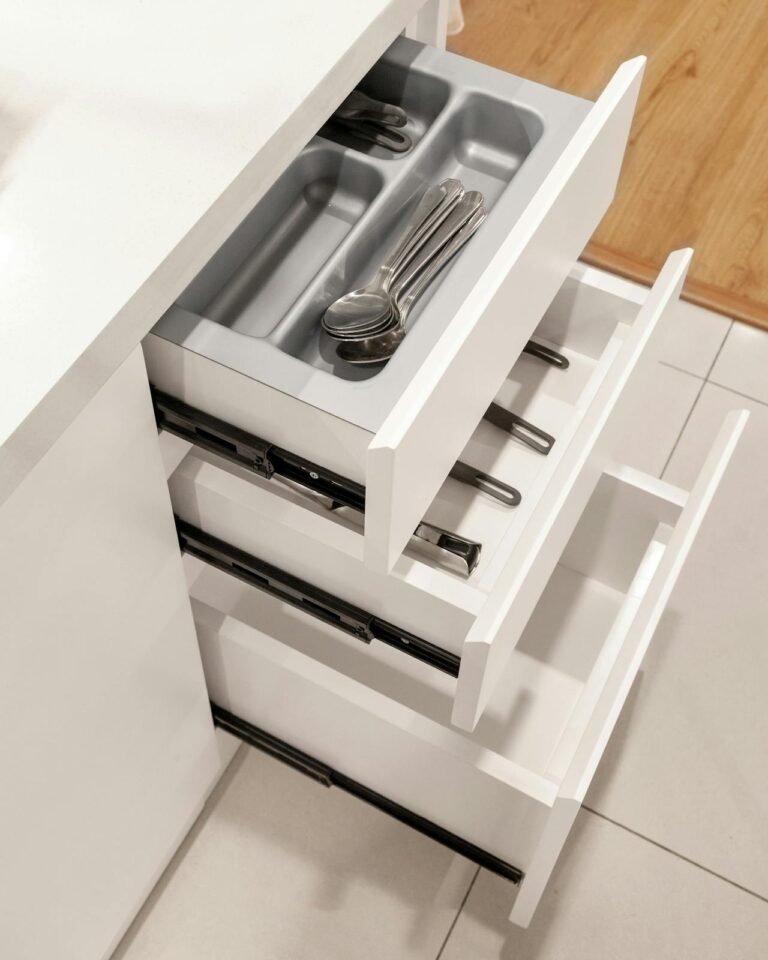A cluttered kitchen can turn meal preparation into a frustrating experience, but learning how to organize kitchen utensils without expensive organizers doesn’t have to break the bank. With some creativity and strategic thinking, you can transform your kitchen into a functional, efficient workspace using items you likely already own or can purchase affordably.
Why Proper Kitchen Organization Matters
Before diving into our clever solutions, it’s important to understand why organizing kitchen utensils efficiently makes such a difference. A well-organized kitchen saves time during meal preparation, reduces stress, and creates a more enjoyable cooking environment. When every tool has its designated place, you’ll spend less time searching and more time creating delicious meals.
15 Creative Solutions to Organize Kitchen Utensils
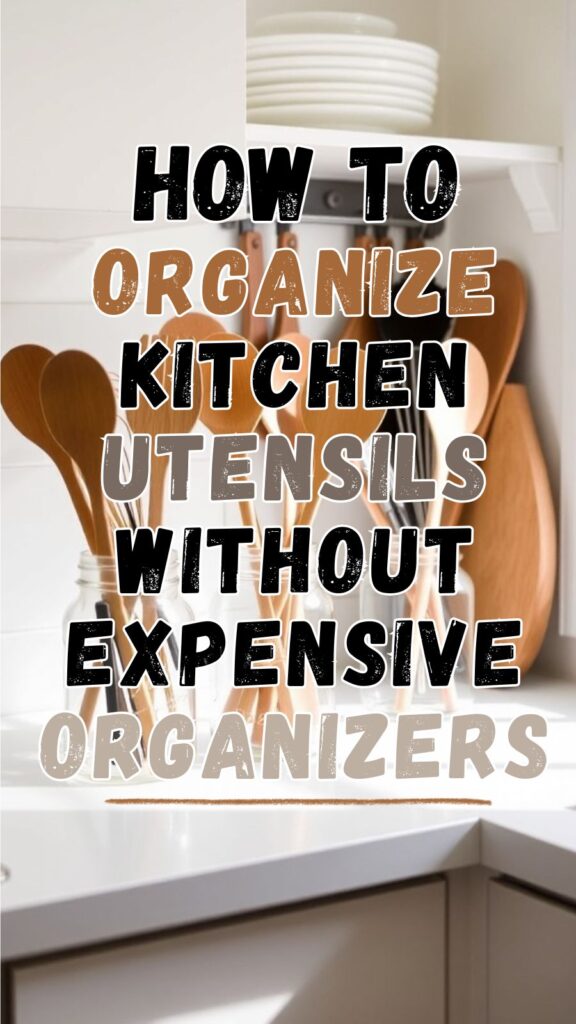
1. Repurpose Mason Jars as Utensil Holders
Mason jars aren’t just for preserving food – they make excellent budget-friendly kitchen organization solutions. Group similar utensils together in different jars: wooden spoons in one, metal spatulas in another, and measuring spoons in a third. This method keeps everything visible and easily accessible.
2. Use Empty Tin Cans for Drawer Dividers
Clean empty tin cans can serve as perfect drawer organizers for smaller utensils. Remove labels completely, sand any rough edges, and arrange them in your drawers to create custom compartments. This zero-cost solution works particularly well for organizing measuring cups, cookie cutters, and small gadgets.
3. Install a Magnetic Strip for Metal Tools
A magnetic knife strip isn’t limited to knives. Mount one on your backsplash or inside a cabinet door to hold metal utensils like tongs, whisks, and can openers. This space-saving utensil storage idea keeps frequently used items within arm’s reach while freeing up drawer space.
4. Create a Rotating Carousel from a Lazy Susan
Transform an inexpensive lazy Susan into a rotating utensil organizer. Add small containers or cups to hold different categories of tools. This solution works exceptionally well for corner counters where space is limited but accessibility is crucial.
Also Read: 7 Clever Ways to Use the Space Behind the Sofa
5. Utilize Ice Cube Trays for Small Items
Ice cube trays make fantastic organizers for tiny kitchen tools and accessories. Use them to sort measuring spoons by size, organize spice jar lids, or keep small gadgets like corn holders and herb scissors neatly separated.
6. Hang Utensils on a Rail System
Install a simple rail or rod under your upper cabinets and use S-hooks to hang frequently used utensils. This DIY kitchen utensil organization method keeps tools visible and frees up valuable drawer and counter space.
7. Repurpose Shoe Organizers for Pantry Storage
Over-the-door shoe organizers work wonderfully for storing kitchen tools in pantry doors or inside cabinet doors. The clear pockets make it easy to identify contents, and they’re perfect for items like measuring cups, small appliances, and cleaning supplies.
8. Use Pegboard for Customizable Storage
A small pegboard section can provide incredibly flexible storage. Add hooks and small containers as needed, and easily rearrange the setup as your collection of utensils changes. Paint it to match your kitchen decor for a cohesive look.
Also See: How to Arrange Bedroom Furniture to Open Up Your Space
9. Convert Cutlery Trays for Drawer Organization
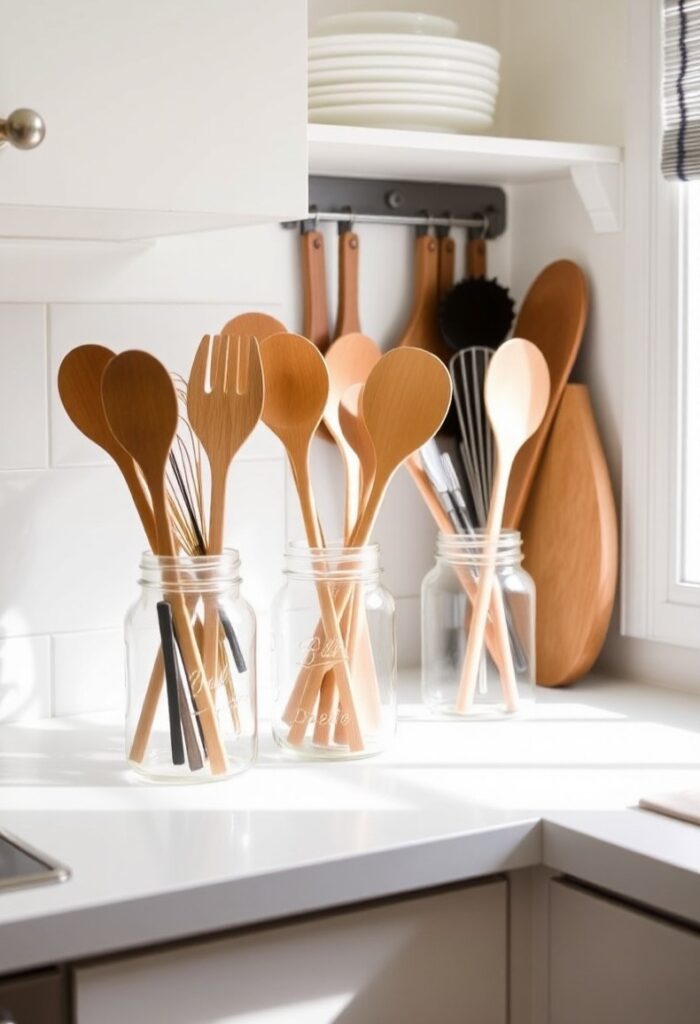
Standard silverware trays can accommodate much more than just forks and knives. Use the compartments to organize cooking utensils by function: baking tools in one section, grilling tools in another, and everyday cooking implements in a third.
10. Create Vertical Storage with Tension Rods
Install tension rods vertically inside deep drawers to create slots for cutting boards, baking sheets, and large flat utensils. This method maximizes vertical space and prevents items from getting buried beneath others.
Advanced Organization Strategies
11. Build a Command Center with Cork Board
A cork board can serve as both decoration and function. Pin frequently used recipes and attach small containers or pouches to hold essential tools. This creates a centralized cooking station that keeps everything organized and within reach.
12. Use Expandable Drawer Dividers
Invest in adjustable dividers that can grow with your collection. These inexpensive tools allow you to customize drawer space perfectly, ensuring every utensil has a proper home regardless of size or shape.
13. Implement the Container Within Container Method
Place smaller containers inside larger ones to create multi-level organization systems. This technique works particularly well for organizing baking tools, where small items like cookie cutters can nest inside measuring cup sets.
Read More: 9 Narrow Bathroom Storage Ideas to Maximize Space
14. Create Zones Based on Cooking Functions
Organize kitchen utensils by grouping them according to cooking tasks rather than type. Keep all baking tools together, grilling accessories in another area, and everyday cooking implements in the most accessible location.
15. Utilize Under-Cabinet Space with Hooks
The underside of upper cabinets offers valuable real estate for organization. Install small hooks or magnetic strips to hold lightweight utensils, freeing up drawer space for heavier items.
Maintenance Tips for Long-Term Success
Creating an organized system is only the first step – maintaining it requires consistent effort. Establish a routine of returning items to their designated spots immediately after cleaning. This simple habit prevents the gradual return to chaos that often defeats even the best organization systems.
Regular decluttering sessions also help maintain efficiency. Every few months, assess your utensil collection and remove items you no longer use. This prevents overcrowding and ensures your organization system continues to work effectively.
Read More: How to Keep the Nightstand Tidy Daily
Budget-Friendly Shopping Tips
When you do need to purchase organization supplies, look for multipurpose items that can serve several functions. Dollar stores often carry excellent organization supplies at fraction of the cost of specialty kitchen stores. Thrift shops and garage sales can also yield treasure troves of containers and organizational tools.
Conclusion
Learning how to organize kitchen utensils effectively doesn’t require expensive specialized products or major renovations. With creativity and strategic planning, you can transform your kitchen into a model of efficiency using affordable or free solutions. The key lies in understanding your specific needs, utilizing vertical space, and creating systems that make sense for your cooking style.
Remember that the best organization system is one you’ll actually use consistently. Start with one or two of these strategies, perfect them, and then gradually implement additional solutions as needed. Your future self will thank you every time you reach for a perfectly organized cooking tool.
Frequently Asked Questions
What’s the best way to organize kitchen utensils in a small kitchen?
In small kitchens, vertical storage is crucial. Use magnetic strips on walls, hang utensils on rails under cabinets, and utilize the inside of cabinet doors with hooks or over-the-door organizers. Prioritize keeping your most-used items in the most accessible locations.
How often should I reorganize my kitchen utensils?
Review your kitchen organization every 3-6 months. This allows you to remove items you no longer use, adjust storage solutions that aren’t working, and accommodate any new tools you’ve acquired. A quick weekly maintenance routine helps prevent major reorganization needs.
What kitchen utensils should I keep on the counter vs. in drawers?
Keep daily essentials like spatulas, wooden spoons, and tongs in counter containers for easy access. Store less frequently used items like specialty baking tools, measuring equipment, and seasonal utensils in drawers or cabinets to reduce counter clutter.
How can I organize kitchen utensils without a junk drawer?
Create designated homes for every item using drawer dividers, small containers, or repurposed jars. Group similar items together and label containers if necessary. The key is ensuring every tool has a specific, logical place rather than being tossed into a catch-all space.
What’s the most cost-effective way to organize kitchen drawers?
Use items you already own: empty food containers, shoeboxes cut to size, or even toilet paper tubes for creating dividers. Ice cube trays work excellently for small items, and tension rods can create vertical dividers for flat items like cutting boards.
Should I organize kitchen utensils by size or function?
Organize by function for maximum efficiency. Group all baking tools together, keep grilling accessories in one area, and store everyday cooking utensils in the most accessible location. This approach makes meal preparation more intuitive and efficient.
How do I maintain an organized kitchen utensil system long-term?
Develop the habit of immediately returning items to their designated spots after cleaning. Involve all household members in the system and make sure everyone knows where items belong. Regular decluttering and occasional system adjustments help maintain long-term organization success.

